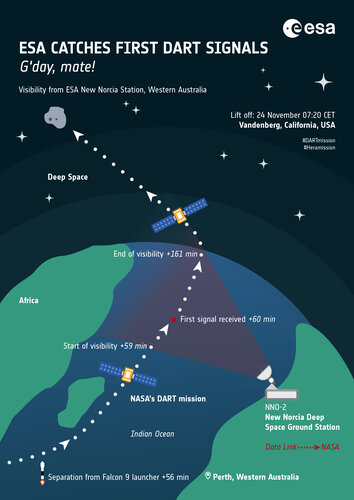Following lift-off, as DART climbs heavenward but Earth rotates beneath it, the spacecraft will follow a unique path in the sky. Passing first down the west coast of South America then east across the Atlantic, it will finally appear above the horizon as seen from Australia.
About 60 minutes after launch, the spacecraft will separate from the launcher, its transponder will turn on, and ESA’s 4.5-metre antenna in New Norcia, Western Australia, will capture its very first words – the ‘acquisition of signal’.
This smaller, more agile radio dish was specifically designed for moments like this. With a wide ‘beamwidth’ it offers a wider field of view than the nearby 35-metre antenna, as well as the ability to quickly tilt and point to target swiftly moving objects in the sky. This capacity is vital, as the antenna will need to find DART as it appears above the horizon, helping to maintain contact as it departs for interplanetary space.
DART’s data, or ‘telemetry’, will inform NASA of the spacecraft’s wellbeing after launch, in particular the status of its automatic deployment sequence, and allow NASA a vital link to send commands to the spacecraft if necessary.



 Image:
ESA's Australian ground station to catch DART's first words
Image:
ESA's Australian ground station to catch DART's first words